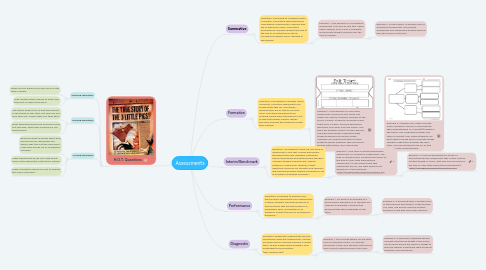
1. H.O.T. Questions
1.1. Opening Questions
1.1.1. What can you predict from the cover of this book? Explain.
1.1.2. Why did the author choose to write from the point of view of the wolf?
1.2. Guiding Questions
1.2.1. The author doesn't tell us how the pigs felt in the middle of this story, but how can you infer they felt? What makes you think that?
1.2.2. What alternative would you propose for the first two pigs, other than using bricks, like the third pig?
1.3. Closing Questions
1.3.1. Based on what you know about how homes hold up, how would you explain why the first two pigs didn't make their homes out of something stronger?
1.3.2. What judgements would you make about each of the characters in the story? Explain.
1.3.3. What information would you use to support the view of the wolf?
2. Performance
2.1. Definition: According to Pearson.com, performance assessments are assessments in which students "generate products or performances that provide evidence of knowledge, skills, and abilities in an academic content domain or professional discipline."
2.1.1. Example 1: An essay is an example of a performance assessment, as students are required to generate a product the demonstrates their knowledge of the topic.
2.1.1.1. Example 2: A demonstration is another form of performance assessment, as the teacher can, then, see exactly how the student performs a task they have been learning.
3. Formative
3.1. Definition: According to Carnegie Mellon University, formative assessments are assessments that are "low stakes," meaning they are of little to no point value. Formative assessments are ongoing, taking place throughout a unit, to help the teacher monitor his/her teaching, and help the students monitor their learning.
3.1.1. Example 1: One example of a formative assessment could be an exit ticket. Exit tickets are used by teachers, typically at the end of a lesson. Students complete an exit ticket after a lesson, typically expressing what they took away from the lesson. This helps the students reflect on their learning, and helps the teacher understand what students gained from his/her lesson. Teachers can modify exit tickets to have students answer whatever they feel would benefit both parties, like in the image above.
3.1.1.1. Example 2: Students can create concept maps, following a lesson, to demonstrate their understanding of concept(s) taught in the lesson. The image above shows one type of concept map, which students can use/create to break apart a concept taught. Teachers might give students the main topic, and have students map off of that topic, to their understanding.
4. Interim/Benchmark
4.1. Definition: According to nwea.org, this type of assessment is one that is given periodically throughout the year, between instruction. Interim/benchmark assessments help teachers "measure student achievement, identify patterns in learning for students, target additional resources for students and teachers, and measure progress toward a standard or set of academic standards and goals."
4.1.1. Example 1: One type of interim/benchmark assessment is a Predictive Assessment. This type of assessment is created to be similar to the end-of-year state administered assessment, to best predict how that assessment will go, and what needs to be worked on in the meantime. -http://michiganassessmentconsortium.org
4.1.1.1. Example 2: A Pacing Assessment is a type of interim/benchmark assessment that covers just the content taught in a term, that may also be found on the end-of-year state administered assessment. -http://michiganassessmentconsortium.org
5. Summative
5.1. Definition: According to Carnegie Mellon University, summative assessments are "high stakes" assessments, meaning they are of high point value. Summative assessments "evaluate student learning at the end of an instructional unit by comparing it against some standard or benchmark."
5.1.1. Example 1: One example of a summative assessment is an end-of-unit test. These exams happen once a unit is complete, and evaluate student learning over the unit as a whole.
5.1.1.1. Example 2: A final project is another form of summative assessment. This project summarizes and showcases student learning over the course of the term.
6. Diagnostic
6.1. Definition: Diagnostic assessments are also sometimes called pre-assessments, as they are given before a teacher teaches a certain topic, to give insight about students' prior knowledge/misconceptions (serc.carleton.edu).
6.1.1. Example 1: One-minute papers can be used prior to teaching a topic, as a teacher introduces a topic and students write about their current understanding of the topic.
6.1.1.1. Example 2: A short quiz, targeting the key concepts that will be taught in the lesson can be given before the lesson is taught to help the teacher understand what students know/are confused about.

